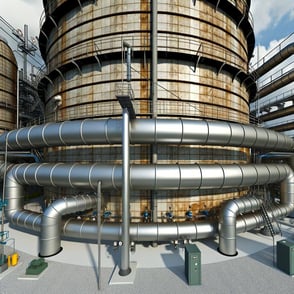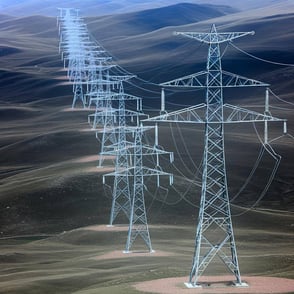Compressed Air Energy Storage
Compressed air energy storages store energy by compressing air and releasing it to generate electricity, balancing supply and demand, supporting grid stability, and integrating renewable sources.
What is Compressed Air Energy Storage?
Compressed air energy storage (CAES) is a form of mechanical energy storage that makes use of compressed air, storing it in large under or above-ground reservoirs. When energy is needed, the compressed air is released, heated, and expanded in a turbine to generate electricity. CAES systems are capable of storing large amounts of energy for extended periods, making them suitable for balancing supply and demand, supporting grid stability, and integrating renewable energy sources.
How Compressed Air Energy Storage Works
CAES systems consist of compressors, storage reservoirs, heat exchangers or recuperators, and turbines. The process can be divided into two main phases: charging (compression) and discharging (expansion).
During periods of low electricity demand or when cheap energy is available, compressors use electricity to compress air. This compressed air is then stored in large underground caverns, aquifers, or above-ground tanks. The compression process generates heat, which can also be captured and stored using heat exchangers to improve the system's overall efficiency. When electricity demand is high, the compressed air is released from the storage reservoir and heated. In traditional CAES systems, the air is mixed with natural gas and burned to generate the necessary heat. The heated air expands and drives a turbine connected to a generator, producing electricity. Advanced adiabatic CAES systems capture and reuse the heat generated during compression, eliminating the need for natural gas and improving efficiency.
In this way, it is possible to distinguish between the two main types of CAES systems: diabatic and adiabatic. In diabatic systems, the heat generated during the compression phase is dissipated into the environment, and natural gas is used to reheat the air during the expansion phase. While effective, this method is less efficient and has a higher environmental impact due to the combustion of fossil fuels. Adiabatic systems capture and store the heat generated during compression and reuse it during the expansion phase. Adiabatic CAES systems are considered more advanced and sustainable compared to diabatic systems. In these systems, recuperators capture the heat generated during air compression and store it. This stored heat is then reused to heat the compressed air before it is expanded in the turbine, eliminating the need for additional fuel and improving overall system efficiency and reducing environmental impact.

The Impact of Compressed Air Energy Storage Systems on the Energy Sector
Compressed air energy storage has a significant impact on the energy sector by providing large-scale, long-duration energy storage solutions. CAES systems can store excess energy during periods of low demand and release it during peak demand, helping to balance supply and demand on the grid. This capability is crucial for maintaining grid stability and preventing blackouts. CAES systems can also provide ancillary services such as frequency regulation and voltage support, further enhancing grid reliability.
As the share of renewable energy sources like wind and solar power increases, CAES systems play a vital role in managing the variability of these sources. By storing excess renewable energy and releasing it when generation is low or demand is high, CAES systems help ensure a consistent and reliable power supply. This capability is essential for integrating more renewable energy into the grid and reducing reliance on fossil fuels.
CAES systems offer cost-effective energy storage solutions, particularly for large-scale and long-duration applications. They can reduce the need for expensive peaking power plants and provide significant cost savings by enhancing the efficiency of energy use and reducing energy losses.
Advanced adiabatic CAES systems have a minimal environmental impact compared to traditional diabatic systems. By eliminating the need for natural gas and reusing the heat generated during compression, adiabatic CAES systems reduce greenhouse gas emissions and contribute to a cleaner energy future. CAES systems also support the integration of renewable energy sources, further reducing the overall carbon footprint of the energy sector.
Conclusion
Compressed air energy storage is a powerful and versatile technology that provides large-scale, long-duration energy storage solutions. By balancing supply and demand, supporting grid stability, and facilitating the integration of renewable energy sources, CAES systems play a crucial role in modern energy systems.
As advancements in technology continue to improve the efficiency and sustainability of CAES, this energy storage solution will become increasingly important in ensuring a reliable, resilient, and sustainable energy future.
Glossary
- Compressed Air Energy Storage (CAES): A technology that stores energy by compressing air and releasing it to generate electricity when needed.
- Compressor: A device that compresses air for storage in a CAES system.
- Storage Reservoir: A large underground or above-ground space where compressed air is stored.
- Heat Exchanger: A device that captures and stores heat generated during the compression phase for reuse during the expansion phase.
- Turbine: A device that converts the kinetic energy of expanding air into mechanical energy to generate electricity.
- Diabatic CAES: A type of CAES system that dissipates heat generated during compression and uses natural gas to reheat air during expansion.
- Adiabatic CAES: A type of CAES system that captures and reuses heat generated during compression, eliminating the need for additional fuel.
- Grid Stability: The ability of the electricity grid to maintain a consistent and reliable supply of electricity despite fluctuations in demand and supply.
- Renewable Energy: Energy generated from natural resources that are replenished continuously, such as wind, solar, and hydropower.
- Frequency Regulation: The process of maintaining the stability of the electrical grid's frequency by balancing supply and demand.
- Voltage Support: The provision of reactive power to maintain voltage levels within the required range for grid stability.
- Recuperator: A component that captures and stores heat generated during compression and reuses it during the expansion phase, improving system efficiency.
.png?width=200&height=80&name=etpa-logo-color%20(1).png)































.png)
.png)
-1.png?width=250&height=100&name=etpa-logo-color%20(1)-1.png)